
Source: Grayscale; Compiled by Deng Tong, Bitchain Vision
summary
-
Cryptocurrencies are a unique highly volatile alternative asset class that may help improve risk-adjusted returns when added to traditional portfolios.
-
When cryptocurrencies are incorporated into your portfolio, a little investment can have a great effect:Traditional portfolio optimization techniques show that an approximate 5% allocation maximizes expected risk-adjusted returns.However, allocating to cryptocurrencies may also increase the risk of the portfolio.
-
Allocation to cryptocurrencies may replace other assets used to increase earnings or diversify, including gold and other commodities, small-cap and international stocks or tech stocks.Crypto asset classes may also replace certain private investments as it can provide more liquidity.
-
Investors should consider their situation and financial goals before investing in cryptocurrencies.This asset class should be considered high risk and may not be suitable for investors with short-term capital needs and/or high-risk aversion.
Building a highly diversified portfolio is becoming increasingly difficult as traditional assets gains are more concentrated, relevance is changing, and macro risks.At Grayscale, we believe that crypto asset classes can be a way to help address these challenges.The crypto asset class includes a variety of technologies with many specific use cases.For example, Bitcoin is a currency system, while Aave is a lending protocol, and Bittensor is a platform for building open source AI.This diversity raises a question for asset allocators:Should crypto assets be considered as commodities, technology investments, or something else when considering portfolio allocations?
Grayscale Research believes thatCryptocurrencies should be considered a unique highly volatile alternative asset class that may help improve risk-adjusted returns when incorporated into traditional portfolios.Although individual assets vary, they are all based on the same underlying technology—public blockchain—and most can be considered early-stage investments.The main difference from other early investment options such as venture capital is the market structure of cryptocurrencies: blockchain-based assets are liquid and traded around the clock worldwide, including many retail investors.These characteristics—early investments traded in the open market of liquidity and can be purchased by anyone—produced a set of statistical properties that can be used to guide portfolio construction.
Crypto Asset Class Behavior
In a relatively short history, the rate of return of crypto asset classes exhibits four main statistical characteristics:(1) High volatility; (2) Return on volatility relative to other major asset classes; (3) Low correlation with traditional assets; (4) Relatively high momentum (statistical durability).[1] In addition, these statistical characteristics tend to evolve over time, especially for more mature digital assets such as Bitcoin.
1. High volatility.Cryptocurrencies are a unique major asset class with extremely high volatility.Since the beginning of 2017, the annualized volatility of the market capitalization weighted index [2] of investable digital assets has been 95%; Bitcoin has been 83% over the same period.By comparison, the S&P 500 has an annualized volatility of 16% and the Nasdaq 100 has an annualized volatility of 19%.Cryptocurrencies are more volatile than certain high-price volatile commodities, such as natural gas or investment strategies that use leverage (Figure 1).therefore,Crypto asset classes should be considered high risk, which is the first consideration that investors should keep in mind before adding crypto assets to their portfolios.
Figure 1: Cryptocurrency is a unique and highly volatile major asset class
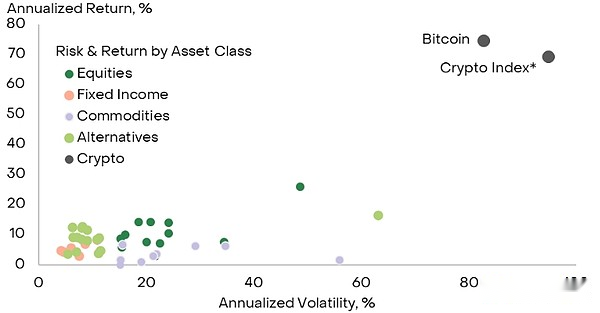
2. Returns are commensurate with volatility.Meanwhile, the returns generated by Bitcoin and the entire digital assets (such as based on market cap weighted indexes) are commensurate with their higher volatility.in other words,Crypto assets compensate investors for the higher risks they bear with higher returns.For example, since the beginning of 2017, the same investable crypto asset market capitalization weighted index has an annualized return of 69%.Given that the annualized volatility is 95%, the ratio of return to volatility is approximately 0.7.During the same period, the S&P 500 had an annualized return of 14%, volatility of 16%, and the return-to-volatility ratio was approximately 0.9.[3] Over approximately 10 years or more, the return-to-volatility ratio of major asset classes tends to be in the range of 0.5-1.0, and cryptocurrency returns are also in this range (Figure 2).Therefore, given its high volatility, the return rate of cryptocurrencies is comparable to that of other asset classes we have observed.
Figure 2: Cryptocurrencies have similar returns to volatility in other asset classes

3. The correlation with traditional assets is low.Higher volatility and higher returns can be achieved through leverage – investing more capital by borrowing money.However, increasing leverage on traditional assets does not affect their correlation and therefore cannot be used to improve risk-adjusted returns.[4]What is unique about the crypto asset class is that it provides high risk and high potential returns while being less relevant to traditional assets (Figure 3).Lower correlations are the “secret” of portfolio diversification and the reason data-driven portfolio optimization approaches often include crypto asset classes.
Figure 3: The correlation between cryptocurrency and stock market returns is low historically
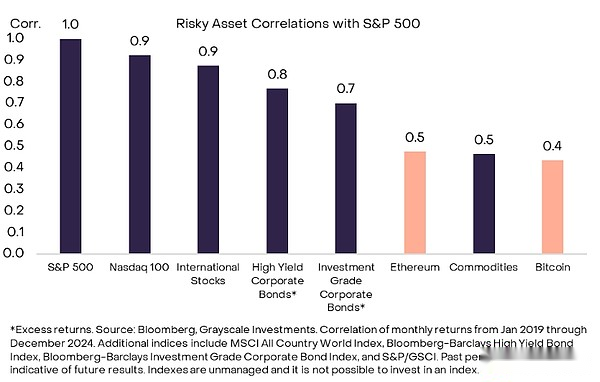
4. High momentum.Compared to stocks and bonds, the historical returns of crypto asset classes show relatively high momentum: returns tend to follow returns, and losses tend to follow losses.In this way, digital asset returns are more similar to those of currency and commodity assets, which also show price momentum.The combination of high volatility and high momentum means that the crypto asset class occasionally produces concentrated periods of sharp rises and periods of sharp declines.Investors who incorporate cryptocurrencies into their diversified portfolios may consider using trend tracking strategies for risk management.
Although the crypto asset class has grown to a considerable scale, it is still relatively young, and its statistical properties may change over time.This is already the case for some more mature assets, such as Bitcoin, and the price volatility of Bitcoin has declined (Figure 4).Grayscale Research believes thatPublic blockchains can be regarded as network technology, and economic theory predicts that the value of a network will be nonlinearly related to the scale of the network.Therefore, as user adoption increases, investors should be prepared for changes in statistical returns behavior of blockchain-based assets.
Figure 4: Bitcoin’s volatility declines over time
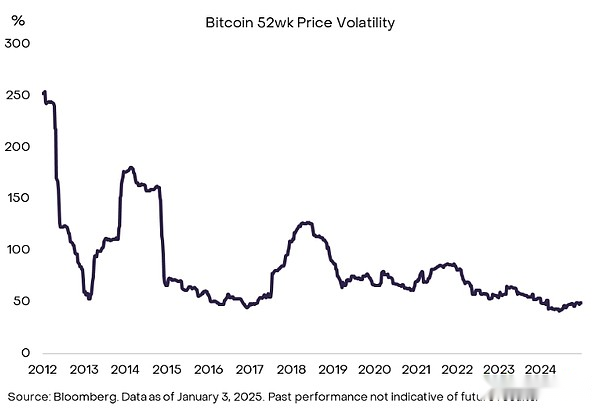
Diversification advantages
When building a diversified portfolio, investors usually consider the expected risks and expected returns for each asset, as well as the expected correlations between assets, to derive a combination of maximum risk-adjusted returns.[5] Inclusion in crypto asset classes is no exception: investors should consider expected risks, returns and correlations based on historical performance and judgments on how future returns may change.
As a benchmark example, Grayscale Research considers incorporating Bitcoin into a traditional 60/40 stock and bond portfolio.[6] We simulated hypothetical portfolios containing different quantities of Bitcoin using the Monte Carlo method.We then estimate the expected annualized return and annualized volatility of the portfolio and calculate the expected Sharpe ratio (see the Technical Appendix for details).[7] For the benchmark example, we assume that the distribution of Bitcoin’s future returns will match the actual returns since 2014.Bitcoin is used as a representative digital asset because of its long history; we will consider portfolios with a wider digital asset in the next section.
Figure 5 shows the results of our baseline simulation.As Bitcoin increases slightly to the classic 60/40 portfolio, the Sharpe ratio is expected to rise initially.The reason is that although Bitcoin is a volatile asset, it can provide high returns and is less relevant to traditional assets, thus having the advantage of diversification.The Sharpe ratio continued to rise until Bitcoin accounts for about 5% of the total portfolio and then began to level off.After this, increasing Bitcoin allocation is no longer expected to increase risk-adjusted returns.
Figure 5: Adding Bitcoin to a traditional portfolio may increase risk-adjusted returns
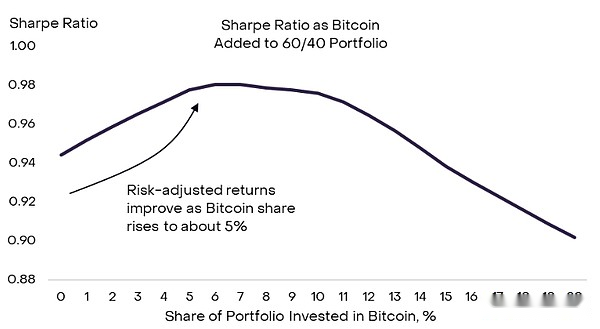
Since cryptocurrencies are a volatile asset class, a small amount of investment can have a huge impact: Even moderate allocation of bitcoin and other digital assets can significantly improve total returns and risk-adjusted returns.For example, Chart 6 shows the hypothetical impact of adding Bitcoin to a traditional 60/40 portfolio in 1%, 3%, and 5% increments.These results are completely hypothetical and do not reflect the actual results achieved by investors.When Bitcoin is added to the 60/40 portfolio at these amounts, the annualized return increases by 0.6-3.3 percentage points (pp) during this period and the portfolio Sharpe ratio increases by 0.05-0.22pp.While both total and risk-adjusted returns are increasing, it must be emphasized that portfolio risk, including maximum drawdowns, also increases.
Figure 6: Assumptions of 1%-5% Bitcoin Configuration on 60/40 Portfolio
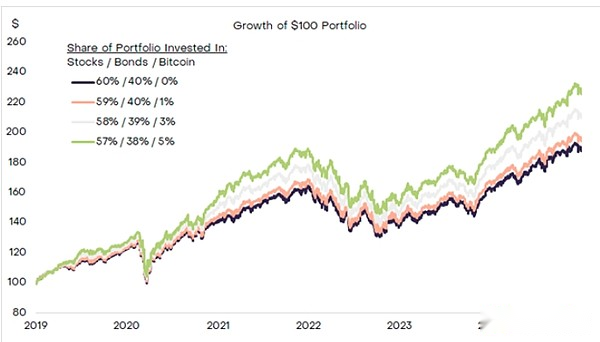

Of course, this is just a simulation under specific assumptions and does not guarantee that future returns will match past returns.Investors should consider a range of possible outcomes of crypto assets before allocating capital.Although an approximate 5% allocation may maximize risk-adjusted returns based on historical results, a lower amount may be appropriate if Bitcoin’s returns decline in the future or its correlation with other asset classes increases.
Frequently Asked Questions
While traditional portfolio optimization techniques may be a useful starting point, investors often need to address various practical implementation issues when allocating crypto asset classes.Here are some of the most common questions we have received from investors about incorporating cryptocurrencies into a diversified portfolio:
1. How will portfolio results change when considering crypto assets other than Bitcoin?Crypto assets with market capitalization below Bitcoin (traditionally known as “altcoins”) generally have higher price volatility and should be considered more risky.Furthermore, asset scope is highly diverse in terms of use cases, market capitalization, and relevance to traditional assets.During the period when the wide index of crypto market performance is available [8], altcoins as a category have a slightly lower total return and risk-adjusted returns than Bitcoin, although this may not be the case in the future.[9] At the very least, investors considering allocating altcoins should adopt a diversified approach that reflects higher specific risks and may need to consider ways to evaluate the specific fundamentals of tokens.That being said, from the surface value of historical data, our Monte Carlo simulation shows thatAbout 5% of the configuration will also maximize the expected risk-adjusted returns for the market-cap-weighted crypto asset basket, including Bitcoin and altcoins.
2. When adding cryptocurrency, what parts of my existing portfolio should I reduce my holdings from?In a diversified portfolio, crypto asset classes can provide return enhancement, diversification, or both.Therefore, it may replace existing configurations designed to provide these attributes, including gold and other commodities, small-cap and international stocks or tech stocks.Cryptocurrencies may also replace certain private investments (such as private equity, venture capital or infrastructure), where it will also provide more portfolio liquidity.Crypto asset classes may offer higher risks and higher potential returns than other asset classes, which may help improve capital efficiency across the portfolio.
3. What is the amplitude and frequency of the past decline?Bitcoin has experienced four long-term declines in its history (Figure 7).Using monthly data, the average peak-to-valley decline in these periods was 77%.As mentioned above, a trend tracking strategy may be used to manage downside risks.There are more examples of smaller declines.For example, during the latest appreciation phase of the crypto market cycle (from December 2018 to November 2021), the price of Bitcoin has risen by about 21 times.However, during this period, the price of Bitcoin fell by at least 10%, a total of 11 times.During the last appreciation phase of the crypto market cycle (from January 2015 to December 2017), the price of Bitcoin fell by at least 20%, a total of 11 times.[10]
Figure 7: Bitcoin has experienced four major declines in its 16-year history
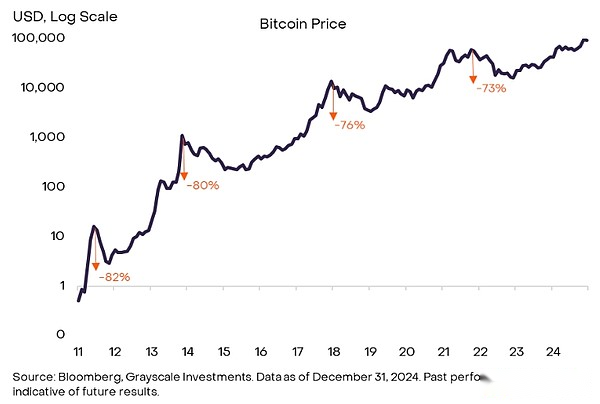
4. Should I consider Bitcoin as a defensive asset?Grayscale Research believes thatBitcoin can be seen as a store of value: we expect it to maintain its actual value for the long term (i.e., consider inflation) because it is scarce and does not depend on any particular institution.Bitcoin today should not be considered a defensive asset that can curb portfolio volatility during a period of recession or other risk aversion.Bitcoin is a highly volatile asset that is positively correlated with the stock market and usually falls when risk aversion intensifies.In addition, at leastCurrently, gold and short-term U.S. Treasury bonds tend to outperform Bitcoin when geopolitical risks increase.
The role of cryptocurrency
It should be emphasized that investing in digital assets may not be suitable for everyone.In this analysis, we consider a representative investor holding a classic 60/40 portfolio.However, in practice, there are many types of portfolios that can meet different financial needs.For example, some investors hold portfolios of low-volatility assets because their capital is designated for upcoming expenses (such as home purchases or college tuition).Cryptocurrencies are a highly volatile asset class that may produce strong returns over time, but may also depreciate significantly in the short term.In addition, some investors favor income-generating assets such as fixed-income securities or dividend-paid stocks.While some crypto assets generate income, in most cases, the returns will be low compared to the volatility of the assets – a category of asset that is primarily used for capital appreciation.
Although there are some exceptions, Grayscale Research’s analysis shows thatTraditional balanced portfolios can achieve higher risk-adjusted returns by moderately allocating cryptocurrencies (which may account for about 5% of total financial assets).Since cryptocurrencies are a high-risk/high-return potential asset class with low correlation with stocks, cryptocurrency assets may help investors overcome some of the portfolio building challenges they are currently facing.Configuring cryptocurrencies does not change other traditional thinking about portfolio construction, including reducing portfolio volatility as it approaches retirement, using tax-promoting accounts where possible, and avoiding trying to seize market opportunities.
Comments
[1] In its early history, Bitcoin also showed positive skew.We do not consider the effect of positive skew in this report, but it did discuss it in a previous report on cryptocurrencies in portfolios.
[2] In this report, we use a composite index of two market capitalization-weighted cryptocurrency price indexes, with the choice of the start date based on data availability.The FTSE/Grayscale Crypto Industry Index Series began in April 2019.Prior to this, the only broad market capitalization weighted index for other available cryptocurrencies’ price returns was the S&P Cryptocurrency Broad Digital Markets Index, which began in February 2017.In this report, our measurement of crypto asset class returns is based on the S&P broad digital market index as of March 2019 and the FTSE/Grayscale cryptocurrency industry index series since then.
[3] Source: Bloomberg, Grayscale Investments.Data as of December 31, 2024.
[4] Risk parity strategies usually apply leverage to low-volatility asset classes such as Treasury bonds, which theoretically improve risk-adjusted returns.
[5] These are the basic concepts of modern portfolio theory, a common method of portfolio building.
[6] This is a simplification because many modern portfolios may contain some alternative asset classes.
[7] When calculating the Sharpe ratio, assume that the cash yield is zero.
[8] As stated in Footnote #2, this is the data from February 2017 to present.
[9] Source: Bloomberg, Grayscale Investments.Based on the FTSE/Grayscale Crypto Sectors Series Index and the S&P Crypto Extensive Digital Market Index.
[10] Source: Coin Metrics, Grayscale Investments.Data as of December 31, 2024.








